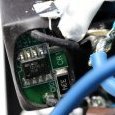Leaderboard
Popular Content
Showing content with the highest reputation on 05/23/17 in all areas
-
The snow you are seeing in the libreelec VM is a HDMI cable problem most likely. Replace it with a good quality cable and if you are using 4k resolution be sure it handles 18Gbps bandwidth. You should remove core 0 and maybe its thread from the emulator pin as unraid likes to use this one. I'm not sure how much CPU is needed for the emulator but try one core for each VM and it should be one that is isolated. I'm speaking about cores you can choose in the VM template and not physical cores.2 points
-
Below is my shameless plug for MrRackables. I've seen too many poor experiences people have had with online resellers that I thought I'd share my positive one. About 5 years ago I built my first unRAID system. At that time, I was primarily focused on having a system to safely store and serve data, mostly media, to client devices in my household. Over the years, as our community has grown leaps and bounds, between the community applications growth in dockers, as well as well as integrating virtual machines, I quickly found myself maxing out my Pentium G2120 & 4GB RAM’s limits. I have spent countless hours on these boards, conversing with fellow forum members about the pros and cons of different hardware. The dual Xeon E5-2670 processors seemed to be a popular choice. While being an older CPU, these can still be had for relatively cheap and provide an insane amount of multi-tasking abilities for people who are really looking to push their server to the limits. I have minimal experience with buying used equipment. However, it seems like a must if you’re not trying to break the bank while attempting to make something that’s at a semi-commercial level for home consumer use. I see plenty of threads pop up about different deals, where to get this or that, who to avoid, and so on. Rather than go on anecdotal information, I decided to take action. I took down the information from all of the top eBay server resellers and reached out. I shared my story, explained that there are many of us on the forums outgrowing our current equipment, and expressed our interest in upgrading to a more robust solution. The one company that stood out was MrRackables. Their level of responsiveness was unparalleled among the resellers I was in contact with. They quickly responded to my email inquiries, and were very helpful and explicit throughout the process. They kept me informed on where things stood from pre purchase to delivery. Their builds setup allows users to pick and choose parts, truly creating a custom system built to order. For what you’re getting, the pricing is great. They had the CPUs I was looking for which got us off on the right foot. Their bread and butter are the Supermicro systems which is great since I’ve always been a fan of their hardware. They had choices from 1U-4U servers which could range from 4-24 hot swap drive bays. They had a nice selection of motherboards allowing for quite a bit of flexibility in total DIMM slots and PCI slots depending on your needs. When I was done researching my options, we came up with this system: 2U Supermicro 12 Bay Server Supermicro X9DRI-LN4F Motherboard 2x Intel Xeon E5-2670 64GB RAM (8x 8GB) LSI 9211-4i HBA CARD 8x 3.5" Caddies 4x 2.5" adapters with 3.5" Caddies Dual 1200W Power Supply Rail kit 4x 1GBE Onboard NIC Dedicated IPMI remote management port The quote came in at $967. I compared prices with other resellers, and could not find anything cheaper. I could have considered buying each part independently to beat the price, but then I'd be dealing with 5+ sellers and 5x the risk that one of my components would be broken. In this scenario, if I had any issues, I was confident that through the rapport I had built with them, that the issue would be quickly resolved. I was sold. I placed the order and we were on our way. It took a couple days to build, was sent via UPS Ground, and was here in under a week, from CA to NY. The packaging thoroughly impressed me. It was not loose in the box with some annoying packing popcorn to secure it. It was tightly packed with styrofoam border and seemed very secure. I took the system out of the box and placed it on my workbench. Unfortunately I'm still looking for a server rack, so this beast will sit desktop for a few weeks until I have that figured out: I gave it it's first boot to test out the specs, All components posted and matched the order. So far so good! I pulled the drives from my current unRAID setup and transferred them to the new system. I realized that I did not have any type of adapter for my 2.5" SSD. After contacting MrRackables, I had 4x adapters here 48 hours later. It was great to see that even post-purchase, a company was still quick to respond and work with their customers to resolve any issues. I booted up, and my oh my, what a sight to see! This system is ready to roll. I have slowly begun to roll out different VM instances, like Windows 10 & Ubuntu. I have added Zoneminder docker for surveillance. I can worry-free run multiple transcoding streams concurrently on Plex. I have installed video cards to the PCI slots without issue. This system handles it, and still has an incredible amount of room for growth. For the price and the ongoing support, I am super stoked about working with MrRackables. They have my full endorsement for anyone still looking for their own custom server to run unRAID. If anyone has any questions, I'd contact their Director of Sales, Justin. He was the one I dealt with from MrRackables and I can vouch for the quality he provided. This is his email. [email protected] DISCLAIMER: I did receive a few small perks, like a few free drive trays and free shipping after mentioning to MrRackables I was doing this review. With that said, I do not work for them, or receive any type of residual on future sales. I'm simply supporting a company which I had a great experience with in a field where many have had issues. If they were to ask how you heard of them, tell them anything you'd like as again, I receive no compensation for my ongoing support.1 point
-
A further update... With the SAS2LP interrupt off Restarted. Fixed the broken files from the backup with reconstruct On to force parity reconstruction for those sectors regardless of the previous parity data. Switched reconstruct back to Auto (which is my normal setting). Ran a complete parity check (was all OK) Checked files that were previously getting corrupted were still OK by reading off the server and then doing a binary compare. Shut down the server completely. Power up. Captured diagnostics just in case (attached if interested). Ran another complete parity check. (Good news - It was still all OK.) So for the time being I shall do a parity check every few days. I normally leave the server running 24/7, but I shall try an occasional restart just to see if I can force the error to come back. But if this has solved it, then we are left with the conclusion that with the interrupt enabled, there can be a small number of destructive writes which need not be confined to the parity drive but which only show up during a parity check. The prevailing view is normally that if there is the odd parity error then a parity correction is required, but that was not the case here At least I have my backups, and no SAS2LP in that machine, just the slower SASLP version. The attached file diffs.zip contains the report from a command line file compare of the backup version of the affected MKV file and the corrupted version. I doubt that it's that useful, but it shows that most of the overwritten data was replaced with zeroes. One passing thought - would a second parity drive have helped to catch this sooner, or have given more clarity as to where the error lay? Or might it just have made life more complicated? tower-v6-diagnostics-20170523-1012.zip diffs.zip1 point
-
1 point
-
IIRC dynamix smart drive db update was released when there was an issue with the smartdb then currently present in unRaid being way out of date. Since then, LT has been updating the smartDB with every release, so the plugin shouldn't be needed anymore (hence why its not available in CA which is why FCP yells about it).1 point
-
Latest version of Plex has been posted. Check for updates on the Docker tab and a update should be available for Plex.1 point
-
1 point
-
Neither, the VM is a separate machine on the network, but unraid routes the traffic internally if you use the virtio network adapter.1 point
-
To always stay up to date with Plex (although personally, I don't see why you need to -> but I'm not a heavy Plex user), you should switch to the linuxserver docker app1 point
-
iommu_groups.txt on the diagnostics system folder, it's blank if iommu is disable, has the groups list if enable.1 point
-
But where's the fun that? Also, if anyone wants to send me free/greatly reduced stuff, I'll put a link to your web store in my sig, make a post 2x as long as this about how great you are, and name my pet turtle after your company. That's true ROI you can't get anywhere else.1 point
-
Are you receiving compensation in any form for this post? If so, it is in everyone's best interest if you disclose.1 point
-
I see a few issues. You have a couple Hitachi disks that are rather slow (sustained data rate (MB/sec) 64.8 - 31 (zone 0 - 29)), disk 2 which is the Seagate ST2000DL003-9VT166_6YD04VWX has read errors and you have performed a parity sync with read errors (corrections to parity made) and there are disk capacity/disk full issues as well. Suggest tackling your disk and capacity issues and things should improve.1 point
-
Check filesystem on disk1 (md1): https://wiki.lime-technology.com/Check_Disk_Filesystems#Drives_formatted_with_XFS1 point
-
I have a STARTECH ASMedia ASM1061 on Supermicro X9SCM-F and it worked right away. I also have it on some HP Micro Severs and it worked with unRAID as well.1 point
-
They should be all the same, I usually prefer to buy an used server pull instead of a new one from China, as these can sometimes be fakes. Also keep in mind that without the expander you'll be limited to SATA cable lengths, max is 1 meter, best option is to get 1 or 2 of these cables depending on how many disk you'll have, 1 meter is enough to connect from the back of one case, go through the back of the other and to the disks:1 point
-
May be. Suggest OP check if mainboard BIOS "Interrupt 19 caputre" enable and add-on card BIOS show or not. Usually, I will disable it, this can reduce the boot time.1 point
-
It should work, probably a bad controller.1 point
-
I have try ASM1061 before, just plug and work. Not sure require or not, I have enable BIOS mainboard AHCI function even no any SATA connect to mainboard. ASM1061 work stable and cool1 point
-
I tested this with Nessus. There are a few vulnerabilities that are reported: SMB Related: --- Windows NetBIOS / SMB Remote Host Information Disclosure Server Message Block (SMB) Protocol Version 1 Enabled (uncredentialed check) Microsoft Windows SMB NativeLanManager Remote System Information Disclosure Microsoft Windows SMB Service Detection1 point
-
I can confirm these settings are not being applied: Server Message Block (SMB) Protocol Version 1 Enabled (uncredentialed check) Description The remote Windows host supports Server Message Block Protocol version 1 (SMBv1). Microsoft recommends that users discontinue the use of SMBv1 due to the lack of security features that were included in later SMB versions. Additionally, the Shadow Brokers group reportedly has an exploit that affects SMB; however, it is unknown if the exploit affects SMBv1 or another version. In response to this, US-CERT recommends that users disable SMBv1 per SMB best practices to mitigate these potential issues.1 point
-
Yeah so doesn't look like these settings are actually applied in "Samba extra configuration" section of the configuration. Devs, can you actually confirm that this is the correct syntax for the settings and it doesn't have to be separated in any shape or form other than EOL? --- min protocol = SMB2guest ok = nonull passwords = nolanman auth = norestrict anonymous = 2encrypt passwords = yesserver signing = mandatoryntlm auth = no1 point
-
Agree the limited power versions of the CPU aren't necessary. Don't agree that they would actually INCREASE the overall power for tasks, but nevertheless it's true that you'll RARELY exceed the power limits of the "T" version anyway, as the standard CPU is very unlikely to draw that much in normal UnRAID usage. And it's true that if you DO need the power, it's nice to simply have it available. As for the stock cooler => Yes, it fits fine in the ITX cases; and provides plenty of cooling for the CPU.1 point
-
No. The thermal limited processors will consume the same if not more power for the same tasks. They just take longer to accomplish the task to keep the average consumption lower, which in turn will keep the drives spun up longer taking more overall power, not less. As long as you can physically dissipate the peak power consumption, it's always better to get the task over and done sooner.1 point
-
Many thanks for chiming in. So far, it's always the same files. One obvious one is a Blu-ray rip - Cast Away, it's around 38GB, so its an easy target. When I compared the backup against the mains server copy I could see that quite a few sectors are getting overwritten - it may be possible for me to see if it's the same corruption each time, but it will take a while. There's also a couple of Windows 10 automatic backup database files that get screwed up. On the plus side, I can at least see where the errors are because I do have a 100% backup. I shall try the disabling the interrupt in the BIOS when the machine has finished the current round of checking (not sure it it's currently enabled or not). I will also need to restore the good files and then recheck everything before I can do a fresh power cycle, so it may be a while before I come back with any more details.1 point
-
Yep The IBM M1015 and the Dell H200 and Dell H310 are all basically the same LSI card under the OEM cover. Just pick which one suits the port layouts you like more. And make sure you buy some SFF-8087 to Sata breakout cables (each cable does 4 drives) and you'll be laughing There's several guides on the internet on how to flash the card to LSI IT mode, which will put it into passthrough where the disks will be seen natively by the OS rather than needing annoying single disk raids Only other caveat is some motherboards don't like booting with the card installed, as it detects as a non server board, personally I haven't had this happen, some guys with SuperMicro mobo's have, but if this happens, don't stress, google for the M1015/H200/H310 pin blockoff - whereby you use electrical tape to block 2 pins on the card to stop the detection and all will be happy Sent from my iPhone using Tapatalk1 point
-
I've turned nfarina's home bridge docker image into a more unRAID friendly one if anyone wants to try it out. https://github.com/ckuburlis/docker-templates Just copy the example config files into the volume, edit as necessary and away you go.1 point
-
After successfully bricking the Fujitsu D2607 by downflashing it I'm proud to be able to contribute to this thread and hereby report: LSI MegaRAID with SAS2008 chipsets 3) DELL Perc H310 as well as H200 Flashed successfully to LSI9211-8i IT (P20) 3TB Drive Support with this card: YES (UPDATE: 5.0Beta7 added 3TB Drive support) Drive Spin Down support: YES (UPDATE: Added as of 5.0Beta7) Drive Temp Readings: YES Toolset_PercH310 to LSIMegaraid.zip (DOS, via bootable usb key) http://www45.zippyshare.com/v/51016808/file.html (for some reason I can't embed the link...) MD5:80174075959fb7d1ff8c6362f7241bfe Update on 06.08.2014 Included the P19 firmware http://www21.zippyshare.com/v/9541812/file.html Update on 01.12.2014 Possible issues with P20 firmware! See this post and this. Update on 23.10.2015 There is an new version of Avago (former LSI) P20 (20.00.04.00) which seems to be OK with unRAID. See this post. Update on 15.09.2015 User opentoe found out that the DELL IT firmware is also working with unRAID. It's your decision what to flash. Flashing DELL firmware is easier and supported by DELL! opentoe's verdict on DELL IT or Avago (former LSI). Update on 07.06.2016 There is a new firmware from Avago. P20.00.07.00 The toolset has been updated accordingly. First impressions. http://www3.zippyshare.com/v/xZKIOHaz/file.html https://www.mediafire.com/?8f82hx4c032a929 MD5: 24f7d428292e00f9dee6f715d8564202 Update on 30.12.2016 Firmware is still P20.00.07.00 Switch to RUFUS for bootdisk creation. Added alternative ways to extract controller info if MegaCli is not working. https://www.mediafire.com/?9cbklh4i1002n23 MD5: 7d90f84c831e8b939c5536d9eb03ba81 Update on 23.02.2017 Firmware is still P20.00.07.00 Uses sas2flsh through the whole process. Tested on a "backflashed" H200, to be confirmed on a stock H200 card and on H310's. Card backup is now dumping the full flash. This can be used to restore the initial condition of the card. Added script for automatic SAS address extraction. No reboot necessary any more. https://www.mediafire.com/?0op114fpim9xwwf MD5: 2fbe3d562846e493714a9e8ac3f15923 Due to missing UEFI environment, no changes nor testing with UEFI shell. Update on 30.03.2017, v2 Firmware is still P20.00.07.00 Spiced up the routines with some checks to automatically select the right tool if one is not working. Tested on a stock H310 as well as a H200 - works for me. Post your experience in the forum. https://www.mediafire.com/?6b77v4s7czluvs2 MD5: 6cb92336ff537aeb838085a028aa6601 Update on 11.04.2017, v3 Firmware is still P20.00.07.00 Added files for use in an EFI environment. Untested due to missing hardware. Post your experience in the forum. https://www.mediafire.com/?9ovj2rxuaf43wv4 MD5: t.b.d. Update on 17.04.2017, v4 <--- this is the latest, use this one! Firmware is still P20.00.07.00 Corrections for EFI environment. Untested due to missing hardware. Post your experience in the forum. https://www.mediafire.com/?py9c1w5u56xytw2 MD5: t.b.d. If you experience the "failed to initialize PAL" error somewhere in step 5, you have to boot from UEFI shell and try again or use another mainboard. See here how to use UEFI shell (Kudos 2 Maglin). Make sure you read and understand the __READMEFIRST.txt before starting! If you experience troubles or something is not clear, don't hesitate to ask for help. You can help improving the howto by doing so. Chances are small but you can brick the controller!1 point










